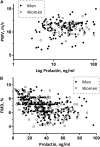Prolactin levels, endothelial dysfunction, and the risk of cardiovascular events and mortality in patients with CKD
- PMID: 22193237
- PMCID: PMC3280028
- DOI: 10.2215/CJN.06840711
Prolactin levels, endothelial dysfunction, and the risk of cardiovascular events and mortality in patients with CKD
Abstract
Background and objectives: Both prolactin clearance and production are altered in CKD. In nonrenal populations, emerging evidence suggests that prolactin participates in the atherosclerotic process. Given the elevated cardiovascular risk of CKD, this study examined links between prolactinemia, vascular derangements, and outcomes.
Design, setting, participants, & measurements: This observational study was conducted in two cohorts: one with 457 nondialyzed CKD patients (mean age 52±12 years; 229 men) with measurements of flow-mediated dilation (FMD) and carotid intima-media thickness and one with 173 hemodialysis patients (65±12 years; 111 men) with measurements of pulse wave velocity (PWV). Patients were followed for cardiovascular events (n=146, nondialyzed cohort) or death (n=79, hemodialysis cohort).
Results: Prolactin levels increased along with reduced kidney function. Prolactin significantly and independently contributed to explain the variance of both FMD (in nondialyzed patients) and PWV (in hemodialysis patients), but not intima-media thickness. In Cox analyses, the risk of cardiovascular events in nondialyzed patients increased by 27% (hazard ratio [HR], 1.27; 95% confidence interval [95% CI], 1.17-1.38) for each 10 ng/ml increment of prolactin. Similarly, the risk for all-cause and cardiovascular mortality in hemodialysis patients increased by 12% (HR, 1.12; 95% CI, 1.06-1.17) and 15% (HR, 1.15; 95% CI, 1.08-1.21), respectively. This was true after multivariate adjustment for confounders and after adjustment within the purported causal pathway (FMD or PWV).
Conclusions: Prolactin levels directly associated with endothelial dysfunction/stiffness and with increased risk of cardiovascular events and mortality in two independent cohorts of CKD patients.
Figures



References
-
- de Jager DJ, Grootendorst DC, Jager KJ, van Dijk PC, Tomas LM, Ansell D, Collart F, Finne P, Heaf JG, De Meester J, Wetzels JF, Rosendaal FR, Dekker FW: Cardiovascular and noncardiovascular mortality among patients starting dialysis. JAMA 302: 1782–1789, 2009 - PubMed
-
- Go AS, Chertow GM, Fan D, McCulloch CE, Hsu CY: Chronic kidney disease and the risks of death, cardiovascular events, and hospitalization. N Engl J Med 351: 1296–1305, 2004 - PubMed
-
- Zoccali C: Endothelial dysfunction and the kidney: Emerging risk factors for renal insufficiency and cardiovascular outcomes in essential hypertension. J Am Soc Nephrol 17[Suppl 2]: S61–S63, 2006 - PubMed
-
- Carrero JJ, Stenvinkel P: Inflammation in end-stage renal disease—What have we learned in 10 years? Semin Dial 23: 498–509, 2010 - PubMed
-
- Hou SH, Grossman S, Molitch ME: Hyperprolactinemia in patients with renal insufficiency and chronic renal failure requiring hemodialysis or chronic ambulatory peritoneal dialysis. Am J Kidney Dis 6: 245–249, 1985 - PubMed
Publication types
MeSH terms
Substances
LinkOut - more resources
Full Text Sources
Medical

